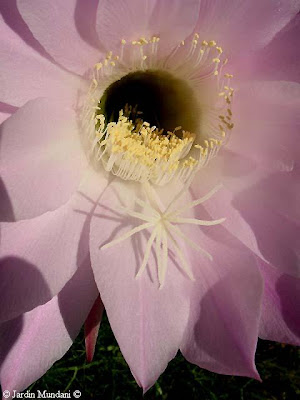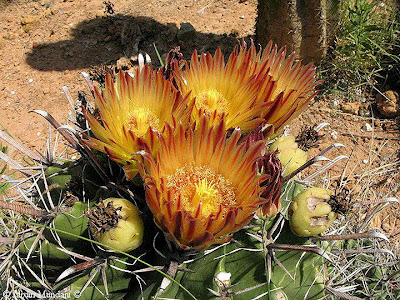The Cactus flowers are very showy with a structural and chromatic design of exquisite beauty. The purpose of their bright colors and delicious scent given off is to attract insects, bats, birds, lizards and rodents that come greedy to suck or lick the rich and abundant nectar flowers background, taking pollen stuck their bodies to other flowers, thus facilitating cross pollination avoiding inbreeding and ensures the survival of future generations.
Hildewintera aureispina, originally from Argentina and Uruguay, photographed in the Soller Botanical Garden on the Mallorca island. (I recommend expanding this and the following photos with a double click to better appreciate the details).
Same flowers earlier. The photographs were taken in August.
Hildewintera aureispina flower with details of the reproductive organs.
Echinopsis multiplex photographed in a small private garden of Monte de Luna situated on the Canarian island of La Palma. This cactus is native to Bolivia, Argentina, Uruguay and Paraguay.
Two flowers of Echinopsis multiplex before. The photographs were taken in May.
Detail of the reproductive organs of a flower Echinopsis multiplex.
Cleistocactus strausii flower from Argentina. The photo was taken in August at Ses Salines Botanicactus, located on the southern coast of the island of Mallorca.
Echinocactus grusonii var. inermis from Mexico photographed in September in the Botanical Garden of Soller.
Two previous cactus flowers.
Flower of Echinocactus grusonii var. inermis surrounded by the typical woolly pilosity covering the center of this cactus.
Echinocactus spiralis from Mexico (Puebla, Oaxaca), photographed in August in Ses Salines Botanicactus.
Previous cactus flowers with a special color design.
Ferocactus glaucescens, called Biznaga, originally from Mexico (Hidalgo), photographed in May at the Botanical Garden of Soller.
Ferocactus horridus from Mexico, photographed in September in Ses Salines Botanicactus.
Flowers as fire flares above Ferocactus horridus.
One of the flowers above in detail.
Thorns, flower and bud of Ferocactus horridus.
Reproductive organs of the flower before.
Ferocactus pringlei from Mexico (Nuevo Leon, San Luis Potosi, Coahuila, Zacatecas), called Biznaga roja.
Flowers side view. The photographs were taken in September in Ses Salines Botanicactus.
Ferocactus robustus from Mexico, photographed in September in Soller Botanical Garden.
Ferocactus robustus beautiful flower earlier.
Hamatocactus setispinus, originally from USA (Texas) and northern Mexico (Taumaulipas, Nuevo Leon, Coahuila), photographed in August in Soller Botanical Garden.
Beautiful flowers with red center of Hamatocactus setispinus, photographed in September.
Mammillaria compressa in May, originally from Mexico (Hidalgo, Queretaro, San Luis Potosi and Tamaulipas), photographed in Soller Botanical Garden.
Mammillaria spinosissima in May, originally from Mexico (Guerrero and Morelos), photographed in Soller Botanical Garden.
Wreath flowers of Mammillaria spinosissima one above.
Three flowers of Mammillaria spinosissima.
Trichocereus terscheskii buds in October. This cactus is native to western Argentina.
Previous buds already open with two pollinating bees attracted by the delicious scent of flowers.
Trichocereus terscheskii beautiful flower.































No comments:
Post a Comment